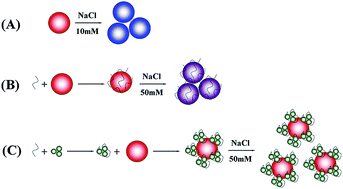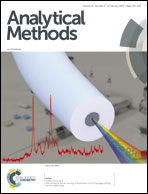A sensitive gold nanoparticle-based aptasensor for colorimetric detection of Aβ1–40 oligomers†
Abstract
In this work, a gold nanoparticle-based label-free homogeneous phase colorimetric bioassay was developed for the detection of Aβ1–40 oligomers (AβO), important biomarkers for diagnosis and monitoring progression of Alzheimer's disease (AD). The prepared AβO-aptamer decorated AuNPs tended to aggregate in a solution with high concentrations of salt, and displayed a purple color with a maximum absorption peak at 650 nm, a characteristic absorption of aggregated AuNPs. In the presence of AβO, the specific binding of the target with the aptamer generated folded aptamer structures, which can stabilize AuNPs towards the salt-induced aggregation more effectively than AuNPs stabilized by the aptamer alone, and thus achieved a hypsochromic shift in the absorption spectra. On the basis of this sensitive spectral transformation, the proposed aptasensor was successfully applied for the detection of AβO with a dynamic range of 1–600 nM and a low detection limit of 0.56 nM. The reliability and practicality of this aptasensor was demonstrated by analysis of AβO in artificial cerebrospinal fluid (aCSF). We anticipate that the proposed facile colorimetric assay for AβO will provide applicable information for early diagnosis of AD.



 Please wait while we load your content...
Please wait while we load your content...